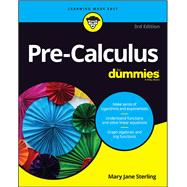Get ahead in pre-calculus
Pre-calculus courses have become increasingly popular with 35 percent of students in the U.S. taking the course in middle or high school. Often, completion of such a course is a prerequisite for calculus and other upper level mathematics courses.
Pre-Calculus For Dummies is an invaluable resource for students enrolled in pre-calculus courses. By presenting the essential topics in a clear and concise manner, the book helps students improve their understanding of pre-calculus and become prepared for upper level math courses.
- Provides fundamental information in an approachable manner
- Includes fresh example problems
- Practical explanations mirror today’s teaching methods
- Offers relevant cultural references
Whether used as a classroom aid or as a refresher in preparation for an introductory calculus course, this book is one you’ll want to have on hand to perform your very best.








